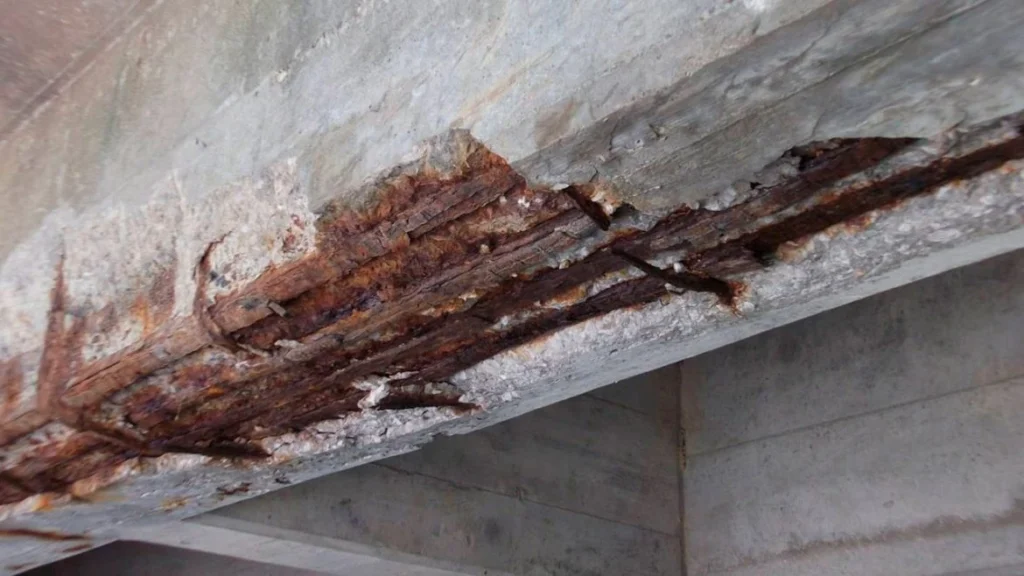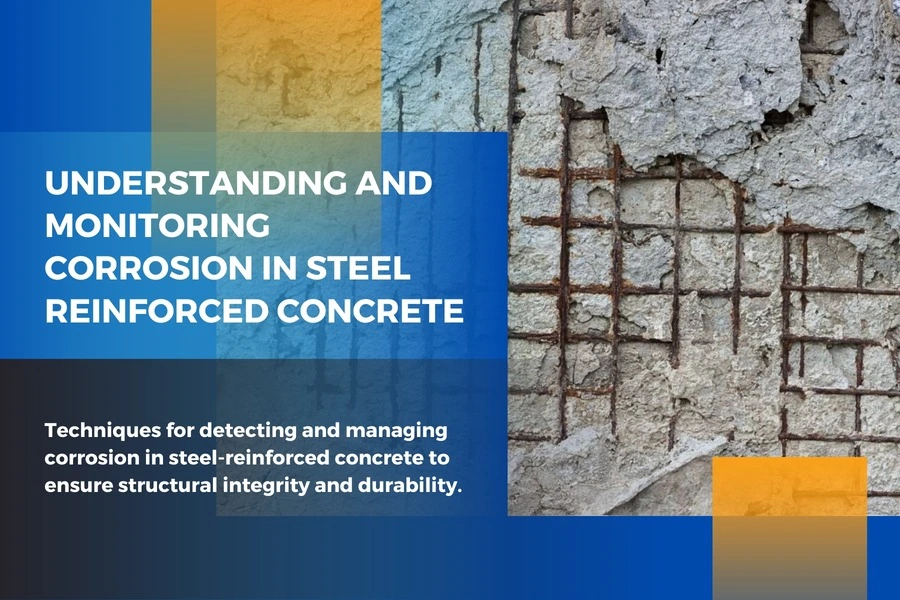Concrete is the most widely used building material around the world, with steel reinforced concrete being incredibly popular. The incredible strength of steel reinforced concrete makes it an ideal building material for large-scale projects, such as skyscrapers, dams, bridges, etc. However, the strength of steel reinforced concrete is sometimes compromised by concrete corrosion.
Table of Contents
Corrosion of the steel reinforcement causes several significant problems, such as weakened structural integrity and decreased durability of the building. Fortunately, there are several solutions to preventing concrete corrosion and ensuring optimal strength and durability of buildings.
In this blog, we will take a closer look at understanding and monitoring corrosion in steel reinforced concrete, its causes, and preventing measures to avoid this problem.
Why is Concrete Corrosion a Problem?
Corrosion of steel-reinforced concrete is a common problem faced by professional builders and contractors all over the world. This issue can cause the problem to grow with time, and ultimately affect the structure’s compressive and load-bearing strength, and decrease its life-span.
Corrosion of steel reinforcement within the concrete tends to make the steel expand in size. This process puts undue tensile stress on the concrete component from within, thus causing spalling, de-lamination and visible cracking in the concrete. All these effects combine and cause damage to the aesthetic of the structure, and adversely affect its structural integrity.
If left untreated, the growing corrosion can raise the maintenance costs and even cause structural failure in new buildings. Hence, the economic and safety repercussions of concrete corrosion are truly significant. For instance, corrosion in steel reinforcement can cause bridges to collapse, and put lives at risk, besides affecting the smooth flow of essential services.
In addition, corrosion of steel reinforcement in concrete also affects its sustainability. There are severe environmental impacts of frequently replacing or repairing corroded concrete structures, as it requires additional materials and increases carbon footprint of construction projects.
Besides this, it is significantly expensive and takes time to repair corroded steel reinforced concrete components, which makes it important to identify the causes of concrete corrosion at the earliest stages.
Causes of Concrete Corrosion
Now that you know what concrete corrosion is, let’s find out its main causes. Identifying the correct cause of corrosion in concrete reinforcement can help prevent the problem or solve it more efficiently.
Below are listed some of the major causes of concrete corrosion in steel reinforced structures –
Carbonating effect
The calcium hydroxide in concrete reacts readily with the carbon dioxide present in the atmosphere, resulting in lowered pH levels. This carbonation process lowers the alkalinity of the concrete which causes the steel reinforcement within the concrete to corrode. Though carbonation is a comparatively slower process, it can speed up in poorly compacted concrete, or in porous concrete surfaces.
Chloride ion infiltration
Chloride ions are mostly found in de-icing materials and other aspects of a marine environment. These ions quickly infiltrate the concrete’s surface and begin breaking down the oxide layer covering the steel reinforcement, thus starting corrosion of the steel.
This problem is most common in coastal regions, or in regions where de-icing salts are frequently used in cold weather.
Improper construction practices
Insufficient curing, inadequate hardening, and using low-grade building materials can also exacerbate corrosion in concrete. These issues can create a readymade way for corrosive materials to reach the steel reinforcement within the concrete structure, and cause it to get corroded.
Besides this, corrosion of steel reinforcement can also be caused as a result of error in execution or impractical design, such as insufficient sealing of joints. This can result in compromising the durability of the concrete structure.
Moisture/Oxygen reaction
Corrosion is most commonly caused by the electro-chemical reactions from oxygen and water. Microscopic pores and tiny cracks in the concrete make the component vulnerable to moisture penetration, which forms an ideal place for corrosion to develop. If the structure is in a humid environment, or is exposed to moisture for a prolonged period of time, then the risk of corrosion is increased significantly.
Environmental aspects
Extreme weather conditions, such as excess hot and cold temperatures, frequent freeze-thaw cycles, chemical spills and industrial pollution are also major causes of concrete corrosion in steel reinforced buildings.
How to Prevent Concrete Corrosion?

There are multiple ways to avoid corrosion of steel reinforcement in concrete structures. These are a combination of practical designing, selecting top-quality materials, and ensuring reliable maintenance practices.
The long list of causes of concrete corrosion can be prevented by using the tips provided by construction experts, such as –
Proper concrete cover
Covering the steel reinforcements within the concrete structure properly helps protect them against harmful environmental factors. Make sure to keep the thickness of concrete cover as per the design standards, besides taking into account the building’s environment and the area’s weather conditions.
Good-quality materials
Using high-grade construction material is another excellent way to prevent concrete corrosion. Top-quality building materials can effectively lower the chances of water and corrosive agents penetrating to the steel reinforcement within the concrete component. Some of the most effective and popular materials to prevent corrosion and enhance inherent durability of steel reinforced concrete are silica fume and fly-ash.
Protective compounds
According to construction experts, you can significantly reduce the risk of corrosion by covering the steel reinforcement with a polymer or epoxy material. These substances form a thin but strong and uniform protective layer over the reinforcement that prevents chloride and water from causing corrosion. In the same manner, you can also treat the concrete surface with siloxanes or silanes coating to prevent concrete corrosion.
Corrosion retarders
There are several corrosion inhibiting construction compounds available in the market that can effectively restrict corrosion of steel reinforcement in concrete structures. These work by neutralizing the harmful ions and lower the rate of corrosion successfully. These special chemical compounds for a smooth and complete layer around the steel reinforcement and makes it less vulnerable to corrosion.
Proper maintenance practices
It is strongly recommended by expert construction professionals to perform routine inspections of steel reinforced concrete structures. This helps with swiftly repairing visible damage, and overcoming other harmful effects of concrete corrosion in a cost-efficient manner. These practices can not only enhance the durability of buildings but also prevent minor issues from becoming significant structural problems.
Assessing Corrosion in Steel Reinforced Concrete Structures
Assessing corrosion in reinforced concrete is crucial to evaluate structural integrity of the structure. It is also important to form the most effective and efficient plan for repairing any damage caused by corrosion in the structure.
Some of the most efficient ways to evaluate corrosion in steel reinforced concrete are –
Visual evaluation
Rust stains, cracks, and de-lamination are visible signs of corrosion in steel reinforcement under the concrete surface. Frequent visual inspections are an incredibly efficient and accurate step in assessing extent of corrosion. Hence, this step is highly helpful especially when used with other diagnostic methods.
Resistance testing
Concrete resistance tests help identify where the concrete is vulnerable to moisture ingress, which is the most common cause of corrosion in concrete. Higher resistance ensures stronger and more durable concrete structures, whereas low resistance can increase the problems caused by corrosion.
Half-Cell Potential testing
The half-cell potential test is an electro-chemical testing method. It is used to calculate the risk of corrosion by checking the electrical potential of steel reinforcement within the concrete component. The areas that show lower potential are most susceptible to damage from corrosion.
Carbonation depth testing
The carbonation depth test requires spraying a special pH indicator chemical on freshly-laid concrete. This helps to determine the depth that carbonation can occur within the concrete’s surface. Knowing the rate of progression of carbonation is essential to evaluate the long-term durability of concrete components.
New Steel Corrosion Detection Technology
Let’s check out some of the new steel corrosion detection technology that can help with preventing or treating corrosion of steel reinforcement in concrete structures –
Acoustic emission monitoring
This steel corrosion detection technology is designed to identify sound waves caused by micro-cracking from corrosion of steel reinforcement. Thus, this test offers real-time data on the health of the concrete structure. It is highly sensitive, which makes the test ideal for early detection of corrosion during a building project.
GPR (Ground Penetrating Radar)
The GPR testing technique generates electro-magnetic waves that can easily detect tiny gaps, small voids, and areas prone to corrosion. This is a non-invasive testing method and does not cause any visible damage to the concrete component. The ground penetration radar technique is also excellent for effective planning of maintenance in the future.
X-Ray CT (Computed Tomography)
The X-Ray CT test gives highly-detailed images of the concrete component’s internal structure. This lets construction professionals to check for potential signs of corrosion and other types of defects. This high-resolution imaging test is extremely essential for forensic evaluation of concrete structures.
Fiber Optic Sensors
Fiber optic sensors are a high-tech solution for detecting corrosion in steel reinforced concrete. This test helps to check temperature, strain, and corrosion within a concrete component. Thus, it helps to constantly monitor the structure’s integrity and durability at different stages of construction.
Non-Destructive Concrete Corrosion Monitoring
Non-destructive concrete corrosion monitoring are excellent for checking concrete corrosion, but without causing significant damage to the concrete structure.
The best ways to perform non-destructive monitoring of concrete corrosion are –
Choose the right technique
Make sure to choose a testing technique according to the accessibility, environment, and condition of the project site. For instance, the GPR testing method is suitable for analyzing the sub-surface area of concrete components, while visual inspection method helps with evaluating the surface of concrete components.
Use multiple methods
Construction experts recommend combining two or more testing methods, such as GPR and half-cell potential tests for a complete evaluation of concrete reinforcement corrosion. Combining multiple tests can help with more effective treatment and prevention of corrosion.
Frequent evaluation
Besides these, it is also advised to perform routine inspection and identify the signs of corrosion in the earliest stages. This is extremely useful to prevent the corrosion from becoming more prevalent and ensuring prompt treatment/prevention of concrete corrosion.
Conclusion
Corrosion of steel reinforcement in buildings is one of the biggest concerns for safety and durability in the global construction industry. It is strongly recommended to use effective monitoring and detection tests to identify the risk and extent of steel reinforcement corrosion.
These tests will also help to choose the best way to combat and prevent concrete corrosion in various types of structures.
According to industrial experts, the most effective and cost-efficient way to prevent concrete corrosion is by using top-grade construction chemicals and admixtures from renowned manufacturers, such as Sakshi Chem Sciences Pvt. Ltd.
FAQS
Which concrete is more prone to corrosion?
Any concrete with a high cement-to-water ratio, having low-grade construction chemicals, using improper curing and with increased porosity is more prone to corrosion.
What is the effect of corrosion on RCC?
Reinforced concrete cement (RCC) experiences corrosion from unwanted expansion of its volume, which causes cracks from increasing internal stress. This can adversely affect the tensile strength and structural integrity of the concrete building.
What is the effect of corrosion on the durability of concrete?
Corrosion causes high level of porosity in concrete, which results in spalling, de-lamination and cracking in the concrete. These affects directly decrease the durability of concrete and shorten its lifespan significantly.
What materials can prevent concrete corrosion?
Some of the best materials to prevent concrete corrosion are epoxy grouts, high-grade cement and aggregates, top-quality construction chemicals, and using non-corrosive steel reinforcements.
Which metal does not corrode in concrete?
Stainless steel and galvanizes steel are less vulnerable to corrosion as compared to conventional steel, as they have lower levels of reactivity. They are exceptionally resistant to corrosive action which makes them ideal for ensuring higher strength and longer durability of buildings.

